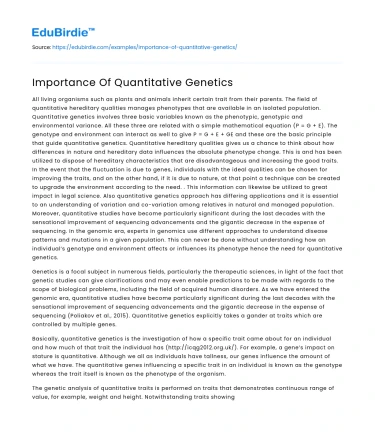Introduction
Quantitative genetics, a branch of genetics focusing on the inheritance of traits that are determined by a multitude of genes, plays a crucial role in understanding complex biological phenomena. It bridges the gap between classical Mendelian genetics and modern genomic studies by providing insights into how multiple genes interact with the environment to influence phenotypic outcomes. As the global population continues to grow, quantitative genetics becomes increasingly vital for addressing challenges in agriculture, medicine, and conservation biology. According to Lynch and Walsh (1998), this field underpins our ability to predict and manage genetic variation in natural and artificial populations, thus holding the key to future advancements in food security and disease management. This essay explores the importance of quantitative genetics, highlighting its applications in agriculture and medicine, while also considering opposing viewpoints to provide a comprehensive understanding.
Applications in Agriculture
Quantitative genetics has a profound impact on agriculture, where it is used to enhance crop yields, improve disease resistance, and increase stress tolerance. By analyzing the genetic basis of quantitative traits, such as height, yield, and drought resistance, scientists can develop varieties that are better suited to changing environmental conditions. For instance, the Green Revolution of the mid-20th century, which dramatically increased agricultural productivity, was largely fueled by advances in quantitative genetics. Borlaug's development of high-yielding, disease-resistant wheat varieties is a classic example of how quantitative genetics can lead to significant improvements in food production (Evenson and Gollin, 2003).
Save your time!
We can take care of your essay
- Proper editing and formatting
- Free revision, title page, and bibliography
- Flexible prices and money-back guarantee
Moreover, quantitative genetics facilitates the implementation of genomic selection, a method that uses genome-wide marker data to predict the breeding value of individuals. This technique accelerates the breeding process by allowing the selection of the best candidates without the need for extensive phenotypic evaluation. As stated by Meuwissen et al. (2001), genomic selection has the potential to double the rate of genetic gain in breeding programs, making it a powerful tool for meeting the demands of a growing population. However, it is important to recognize that the success of these applications depends on the accurate estimation of genetic parameters and the availability of diverse genetic resources.
Role in Medical Research
In the medical field, quantitative genetics contributes to understanding the genetic architecture of complex diseases, such as diabetes, heart disease, and mental disorders. By identifying the genetic variants associated with these diseases, researchers can gain insights into their underlying biological mechanisms, which can lead to the development of novel therapeutic strategies. For example, genome-wide association studies (GWAS) leverage quantitative genetic approaches to identify common genetic variants that contribute to disease risk. These studies have successfully pinpointed loci associated with conditions like type 2 diabetes, providing targets for drug development and personalized medicine (Visscher et al., 2012).
Additionally, quantitative genetics aids in the prediction of disease risk and treatment response, enabling a more personalized approach to healthcare. By integrating genetic information with clinical data, healthcare providers can tailor interventions to individual patients, improving outcomes and reducing healthcare costs. Despite these advances, challenges remain in translating genetic findings into clinical practice, as the effects of most genetic variants are small and influenced by environmental factors. This highlights the need for continued research and the integration of quantitative genetics with other disciplines, such as epigenetics and systems biology, to fully realize its potential in medicine.
Challenges and Counterarguments
While the benefits of quantitative genetics are undeniable, there are challenges and criticisms associated with its application. One major concern is the complexity of genetic interactions and the difficulty in pinpointing the exact contribution of individual genes to a trait. Critics argue that the polygenic nature of many traits makes it challenging to achieve precise predictions and interventions. Moreover, ethical considerations arise with the potential for genetic manipulation and the unintended consequences of altering genetic material. As noted by Franklin (2007), the ethical implications of using genetic information must be carefully considered to ensure responsible and equitable applications.
Another counterargument centers around the reliance on genetic approaches at the expense of environmental and social factors. Some scholars argue that focusing too heavily on genetic solutions may overlook the importance of non-genetic interventions in addressing issues like health disparities and food security. This underscores the need for a holistic approach that considers both genetic and non-genetic factors in solving complex problems. By acknowledging these challenges, the field of quantitative genetics can evolve to address these concerns and continue to contribute meaningfully to science and society.
Conclusion
In conclusion, quantitative genetics holds significant importance in modern science, offering valuable insights and solutions in agriculture, medicine, and beyond. Its ability to improve crop varieties and enhance disease understanding demonstrates its potential to address some of the most pressing global challenges. While there are valid counterarguments and ethical considerations, the continued advancement of quantitative genetics, in conjunction with other scientific fields, promises to drive innovation and improve quality of life. As the world faces increasing demands on food production and healthcare, the importance of this field is likely to grow, making it an indispensable component of scientific progress.






 Stuck on your essay?
Stuck on your essay?

